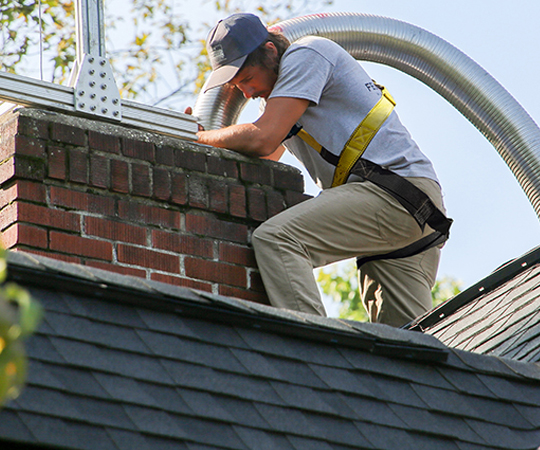Chimney Installation, Replacement, and Repairs
100% Customer Satisfaction Guaranteed! 24/7 Service One-Hour Emergency Service.
The Importance of Furnace Liners
Furnaces, boilers and hot water tanks exhaust large quantities of water vapor during the normal combustion process of natural gas. Oil and gas furnaces produce by-products which can literally eat away the flue lining. Any type of furnace liner that is breached can cause a fire, since heat can reach combustible parts of the home. Clay liner that have gaps or cracks, allow this moisture into the interior structure which eventually deteriorates the masonry structure from the inside out. Additionally, gases vented from gas burning appliances can escape the lining and migrate into the home.
For decades, federal and professional safety organizations have recommended installing a liner in your chimney as a protective measure. Chimney liners provide an additional layer of fireside protection and reduce corrosion on the chimney walls. As an additional benefit, chimney liners improve the efficiency of appliances to scale back utility costs.
Blockage in a furnace flue is extremely hazardous because it can cause carbon monoxide fumes to enter your home.
One of the most common problems that can occur with chimneys is blockage, regardless of what type of furnace fuel is used.
A furnace flue inspection should be scheduled
- At least once per year
- Before moving into a new home
- Before / After the installation of a new furnace
A chimney liner insulates the chimney and puts a stop to flue gases from entering your home
In addition a chimney liner:
- Increases structural stability of the chimney
- Eases maintenance
- Improves fuel efficiency
- Increases fireplace safety
In Need of Chimney Cleaning Services?
We are specialized in chimney sweep, chimney liner, chimney repair, fireplace repair, fireplace damper repair, chimney inspection. Contact us at 973-513-5475 to set up an appointment today.
Why is it Important to Install a Chimney Liner?
Chimney liners serve as an extra layer between the inside of the chimney and the framing of your home. This provides another layer of protection as common defects can appear in the chimney. Defects, no matter how small, can begin a process that will further erode the chimney and can pose a threat to your family’s safety through the creation of health risks. Poisonous gases could potentially infiltrate the home.
More importantly, combustible creosote or soot can also escape through these openings and build up outside the chimney flue liner. If the creosote were to catch fire in this area of your chimney, serious damage can occur, because the fire can no longer be contained within the flue. Homes built prior to the 1940’s were typically built without a chimney liner. As a result, chimney and house fires were more common. Today, there are a few reasons why you may need a new liner: If your chimney has no liner, if it was installed improperly, or if it’s deteriorating or defective.
What are three main types of chimney liners?
Aluminum Liner
Stainless Steel Liner
Terra Cotta Liner
All three types provide adequate protection but which liner is appropriate for your home, should be determined by a professional. Doctor Chimney Company can assist with this and ensure that your chimney liner installation goes smoothly.
Do All Chimneys Have Liners?
Although a damaged liner is incredibly dangerous and should be addressed immediately, a missing liner, naturally, is even more dangerous. It might not be common knowledge but chimneys haven’t always been constructed with flue liners. As a result, countless fires occurred over the years, and it was determined that building a chimney without a liner was “little less than criminal.” If your chimney is missing a liner, it’s imperative that you have it lined before enjoying a fire in your fireplace or stove.

